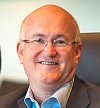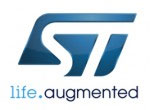Keynote Speakers
Gregg Bartlett
SVP, Chief Technology Officer

Gregg Bartlett is senior vice president and chief technology officer at GLOBALFOUNDRIES. In this role, he is responsible for the company technology strategy, research, technology partnerships and alliances, and packaging technology development. He serves as the company's primary spokesperson on technology matters.
Bartlett joined GLOBALFOUNDRIES in 2009 after a 25-year career in technical and management positions at Freescale Semiconductor and its predecessor, Motorola's Semiconductor Products Sector.
Prior to joining GLOBALFOUNDRIES, Bartlett served as vice president of design technology at Freescale, responsible for design methodology and the creation of design collateral for advanced solutions across networking, automotive, wireless and analog product markets. His tenure emphasized collaborative R&D efforts, including executive representation of Freescale in the Crolles 2 Alliance in Europe.
Bartlett is a member of the board of directors of the Semiconductor Research Corporation and Executive Committee, as well as various consortia governance committees. Bartlett holds a bachelor's degree in chemical engineering from Kansas State University.
Keynote Abstract:
"MEMS Goes Mainstream: The Emerging Role of CMOS Foundries in MEMS Manufacturing"
A new window of opportunity is emerging for large-scale manufacturing of MEMS products with designs provided by fabless and fab-lite companies. In today’s dynamic landscape, designers of MEMS products are demanding a new set of capabilities from their manufacturing partners, including modular technology platforms, standardized interfaces, and larger wafer sizes to take advantage of economies of scale—all while providing the fastest possible time-to-market to accommodate design cycles that are measured in months, not years. With their heritage of serving fabless and fab-lite customers and expertise in high-volume, cost-effective manufacturing on the latest technologies, traditional CMOS foundries are best positioned to take advantage of this new landscape. However, a number of challenges need to be addressed to continue driving the industry forward. MEMS manufacturing has traditionally used specialized tools and processes following a “one-product, one-process” approach.
CMOS foundries must develop new standardized process capabilities, technology platforms, and intellectual property to enable high-volume foundry manufacturing of MEMS devices. Additionally, advanced packaging technologies such as System-in-Package (SiP) and chip stacking with through-silicon vias (TSVs) will be necessary to allow manufacturers to package all of this functionality more densely, combining multiple MEMS sensors with analog and digital devices in a single package.
To overcome these challenges, CMOS foundries need to transition from “contract manufacturers” to “solution providers,” offering solutions across the value chain from design support to process technology to assembly and test. Key to this new model is the need to embrace partnerships at all levels, including research institutes, EDA and IP companies, industry consortia, and OSATs. And of course foundries need to work more and more closely with their customers to become true partners in value creation. In the broader semiconductor market, the success of many fabless and fab-lite companies has been the result of the rise of CMOS foundries. History may be repeating itself in the new high-volume MEMS landscape.
Donald Jones
Vice President, Global Strategy & Market Development, Qualcomm Life
 Donald Jones serves as vice president of Global Strategy & Market Development at Qualcomm Life, Qualcomm’s healthcare subsidiary. He is responsible for Qualcomm’s market development of wireless technologies and platforms in the health, fitness and life sciences markets, and is recognized as a leader in the field. Jones is also Chief Digital Officer at the Scripps Translational Science Institute, working with Eric Topol, MD, on the digital convergence of genomics and wireless health. He is founder and Chairman of the Wireless Life Sciences Alliance (WLSA), a 501c (6) trade organization (www.wirelesslifesciences.org). In 2011, Jones designed the $10 million Qualcomm Tricoder Xprize, a global competition currently underway to design a consumer usable device which can make medical diagnoses (www.qualcommtricorderxprize.org).
Donald Jones serves as vice president of Global Strategy & Market Development at Qualcomm Life, Qualcomm’s healthcare subsidiary. He is responsible for Qualcomm’s market development of wireless technologies and platforms in the health, fitness and life sciences markets, and is recognized as a leader in the field. Jones is also Chief Digital Officer at the Scripps Translational Science Institute, working with Eric Topol, MD, on the digital convergence of genomics and wireless health. He is founder and Chairman of the Wireless Life Sciences Alliance (WLSA), a 501c (6) trade organization (www.wirelesslifesciences.org). In 2011, Jones designed the $10 million Qualcomm Tricoder Xprize, a global competition currently underway to design a consumer usable device which can make medical diagnoses (www.qualcommtricorderxprize.org).
Jones is a Member of the World Economic Forum Health and Healthcare Industry Project Working Group. He is on the boards of the Alliance Healthcare Foundation (www.alliancehf.org) and the American Telemedicine Association (www.atmeda.org). Jones was a founding board member of the West Wireless Health Institute (now the West Health Institute www.westhealth.org). He was formerly the COO of Medtrans, now EMSC, the world’s largest emergency medical services company (www.emsc.net). He was founder and Chairman of EMME (www.emme.com.mx), Mexico’s largest consumer membership healthcare company. In 2010, the San Diego Transcript named Jones one of ‘San Diego’s Top Influential’s and Fierce Health IT named Jones one of the 10 Disruptive Forces in Health IT. In early 2010, Jones was named to the Consumer Innovations Solutions Board at Sanofi Pharmaceuticals.
Jones holds a bachelors’ degree in biology and bio-engineering from the University of California, San Diego, a Juris Doctor from the University of San Diego and an MBA from the University of California, Irvine. Jones holds multiple issued and pending patents in the use of cell phones in incentive reward programs, asynchronous media communications and health care.
Keynote Abstract:
Mobile and the Future of Health and Wellness
Today’s advanced wireless devices, applications and services have captured the imagination of the public, and the benefits of “always on, always with you” connectivity are becoming increasingly apparent to medical professionals, caregivers and health care consumers. Wireless biometric and remote monitoring devices such as body-worn sensors, environmental sensors, medical implants and smart phone apps have significant potential to enhance preventative care, increase the efficacy and efficiency of medical solutions and reduce health care costs while enabling consumers to more easily manage their own health. From breaking down geographic and economic boundaries, to streamlining clinical workflows while enhancing communication between patients and health care providers, digital health care solutions are quickly becoming an integrated element of today’s consumer lifestyle.
For this presentation Don Jones will discuss current solutions being deployed both in the U.S. and abroad and what scalability and clinical benefits have been seen to date. He will also provide the audience with an update on the Tricorder X-Prize competition.






















